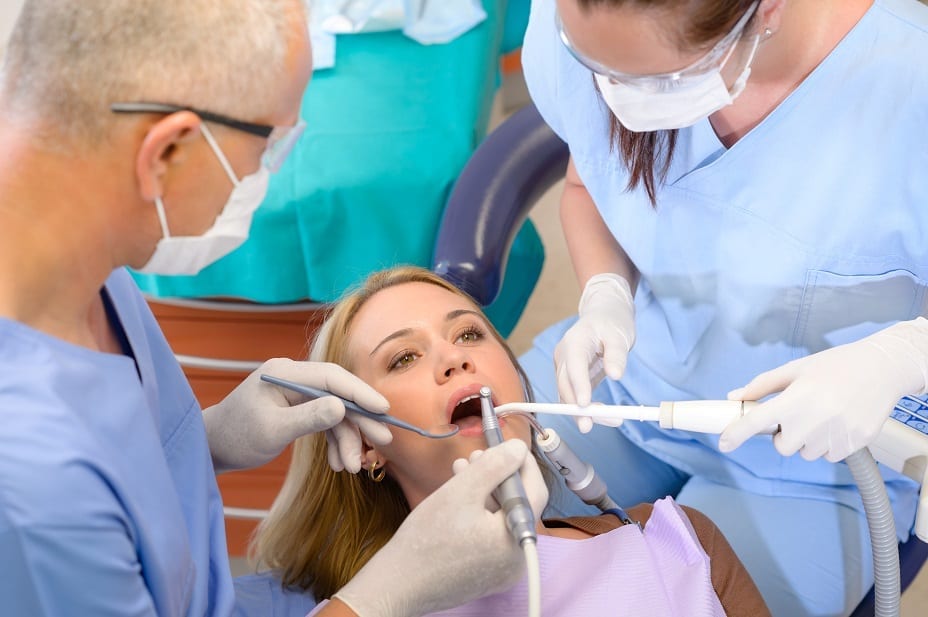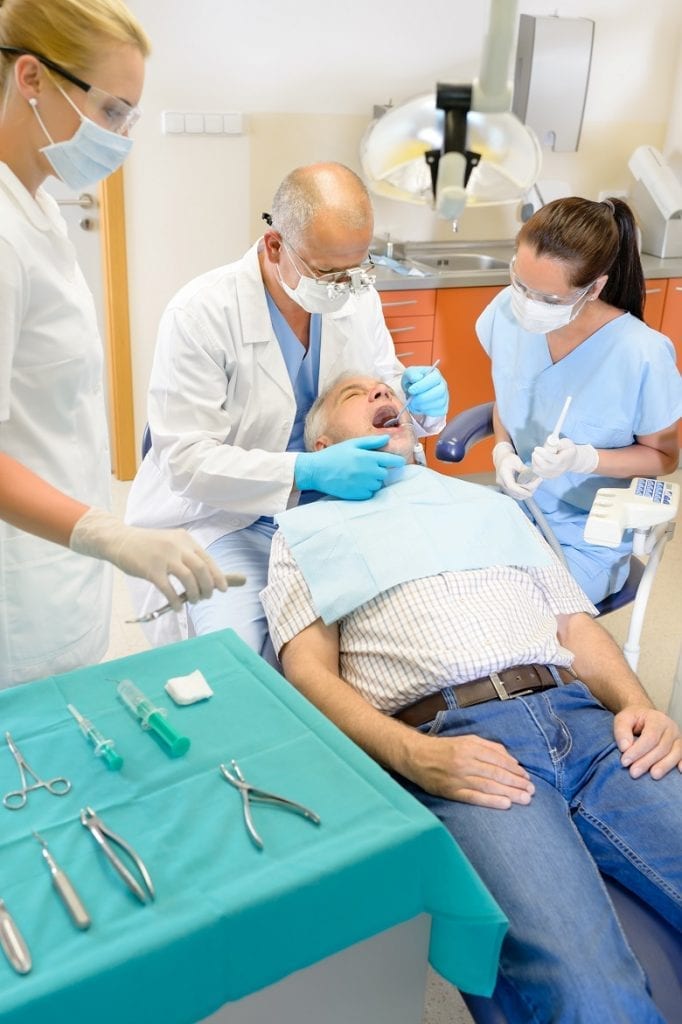Dental surgery is a part of dentistry, which is a branch of medicine dealing with teeth, gums, and the mouth. Dentists are the practitioners of dentistry and they deal with the treatment, prevention, diagnosis, and study of conditions, disorders, and diseases of the oral cavity. This covers the oral mucosa and the dentition as well as all related tissues and structures (like the jaw and facial or maxillofacial area).
To the general public, dentistry and dental surgery are mostly associated with fixing teeth. However, dental medicine isn’t only about fixing your teeth but also covers other aspects of craniofacial complex, such as the temperomandibular structure and other supporting structures. In turn, dental surgery procedures don’t only cover root canals and removal of wisdom teeth that are impacted.
What Exactly Is Dental Surgery?

Dental surgery is the surgery of jaw bones and teeth. Therefore, it covers quite a number of dental procedures or medical procedures that involve artificial modification of dentition. It includes the following procedures below.
Dental Surgery Procedures
1. Endodontic: This is a type of surgery involving the root or pulp of the tooth.
a. Root Canal: A root canal surgery is an endodontic treatment done by an endodontist or dentist in order to treat a diseased or damaged tooth with the tooth root exposed. It involves removing the inflamed tooth pulp and tooth root from underneath the enamel and dentin in order to relieve pain and save a tooth from extraction (hence creating a root canal).
The infected tooth is drilled and has its pulp removed, only to be replaced with an inert substance. Afterwards, a crown is placed atop the tooth to save it. In the past, a root canal was infamous for its painfulness. However, modern endodontic therapy of the root canal is nothing like the old days. It’s much more efficient and less painful than before.
b. Pulpotomy: This is the precursor to a root canal procedure. It involves opening the tooth’s pulp chamber for the sake of draining the pulp infection. To be more specific, it removed the diseased portion of the pulp and leaves alone the rest of the pulp so that there’s no need for a full-blown root canal procedure.
This endodontic treatment is used in case the patient wishes to maintain the vitality of the remaining healthy pulpal tissue. Its advantages include having living teeth preserved that’s able to tell hot from cold temperatures as well as receive nutrients from your blood. A tooth with the root removed is more likely to crumble and break, hence the placement of a crown atop it.

c. Pulpectomy: This procedure involves removing all the pulp in the pulp chamber temporarily for the sake of pain relief. Pulpectomy is typically called for when pulpotomy isn’t an option and all of the tooth’s pulp has become infected, inflamed, and disease-ridden. After removal, the canals are medicated and cleaned.
Sometimes, dentists do pulpectomy on primary or milk teeth. In such cases, the pulp is replaced with resorbable material. This is the recommended course of action for irreversible pulpitis on redicular and coronal pulp as well as primary molars that are abscessed or have radiographic proof of furcation pathology.
d. Apicoectomy: This is used when the full root canal surgery (including the placement of inert material and prosthetic crown) isn’t enough to relieve pain. This root-end resection involves removal of the apex or the end of the root by entering through the gums and surgically extracting this diseased material.
This is also known as a retrograde root canal treatment, root resection, and root-end filling. Its technical name is a combination of “Apico” and “ectomy” or the removal of the very tip of the tooth root, so that the resulting cavity is prepped up then filled with a biocompatible material. This may be done using microsurgical Endodontics or dental surgery with a microscope.
2. Prosthodontics: This is a dental surgery involving dental prosthetics or prosthetic tooth replacement.
a. Crown (Caps): The placement of caps or crowns has been touched upon by the previous section. These artificial coverings for teeth are made from various biocompatible materials, such as a tin or gold and aluminium mixture, CMC/PMC (ceramic/porcelain metal composite), and so forth. To accommodate the crown, the underlying tooth must be reshaped thusly.
It’s the dental surgery for your teeth that ensures you’re given a tougher tooth covering than using tooth filling (which breaks easily, especially when dealing with the enormous biting forces of a molar). A crown can be used on a tooth that’s already dead and crumbling or a tooth that requires a root canal procedure in order to kill it.
b.Veneers: This is also an artificial covering like the crown, but this time they cover only the forward surface of your tooth (in other words, the buccal or labial portions). They don’t replace or reinforce the teeth-biting capabilities of your tooth. In fact, they’re more for aesthetic reasons than anything else.
Also known as dental porcelain laminates or porcelain veneers, they differ from crowns in that they’re as thin as wafers and you don’t have to drill the underlying tooth as much to reshape it and allow it to better receive these dental prosthetics. The shells are bonded to the front of the teeth in order to change their length, size, shape, and color.
c. Bridge: If several teeth have been extracted by a dentist that leaves a wide gap of sorts between one remaining tooth to the next, then you can fix it by putting up a bridge. A bridge is a row or set of fixed prosthetic crowns. It has two or more crowns connected together. They replace a missing tooth or teeth by putting them up in “posts”.
The posts are the adjacent teeth that a dentist reshapes to allow the placement of the crowns on both ends of the bridge. This method of dental prosthetics is usually used after extraction for the sake of saving or preserving your bite. To be more specific, whenever there’s one or more teeth extracted, the other teeth will gradually shift and move towards the gap. This alters your bite and even your jaw length.
d. Implant: Instead of reshaping adjacent teeth in order to place a bridge over them and the tooth extraction site, you can opt for implants instead. These are titanium studs or posts that are surgically placed into the tooth socket and bone (maxilla or mandible) where your tooth or teeth used to be.
After placement, the area is then allowed to heal for about 4 to 6 months. Afterwards, an artificial tooth is placed atop the implant (usually an abutment and crown). The crown is typically connected to the implant by a screw or cement to keep it affixed. The abutment meanwhile fills the space inside the crown that’s usually reserved for the reshaped teeth.
e. Dentures (False Teeth): A partial or complete set of false teeth or dentition. You can attach them to neighboring teeth like in the case of dental bridges. However, unlike bridges, you don’t have to reshape any teeth at all. These prosthetic appliances are secured to your teeth with metal or plastic caps.

You can also place false teeth by the palatal or gingival surface through adhesives. You can choose between temporary or detachable false teeth that you can place in a glass of water when you’re about to sleep or permanent false teeth that you have to stick into your mouth like dental bridges.
f. Implant-Supported Prosthesis: This type of dental surgery combines both implants and dentures together. Instead of using adjacent teeth to serve as the posts or supports of your dental bridge, you instead surgically put in implants on opposite sides of a row of tooth gaps.
As established above, implants require you to place bases deep into the jawbone where the extracted teeth used to be. Again, after the posts are inserted into the tooth socket and then allowed to heal, these metal studs are fixed to the gum surface, allowing placement of dentures or dental bridges atop the affixed dental appliances.
3. Orthodontic Treatment: This involves placing devices on your teeth to alter their placement and to correct your bite.
a. Implants and Implant-Supported Prosthesis: These Prosthodontic procedures can be considered orthodontic treatments in their own right in light of their orthodontic benefits. This is because the bone is involved and they’re used to keep your mouth shape, jaw shape, and bite shape from changing due to gaps between your remaining teeth after an extraction or several extractions.
Implants are used not only to replace the tooth or teeth you’re missing by surgical placement of a dental stud on the tooth socket and bone where your tooth or teeth used to be. They can also preserve your original bite. Orthodontists can even reshape your bite and jaw for the better through the above mentioned processes.
b. Apicoectomy: As established earlier, apicoectomy is the removal of the Apico or root-end of the tooth. Root canal surgery isn’t orthodontic in nature because it mostly focuses on the removal of the tooth pulp and tooth root, thus effectively killing the tooth in the process. However, the apex or end of the root is left alone.
It’s only when root canal surgery proves insufficient in relieving tooth pain that all the material of the apex of the root is removed (usually because even that part of the tooth has become diseased). This is also considered an orthodontic procedure because part of the underlying bone structure needs removal with this type of surgery.
c. Extraction: The removal of a tooth. This usually is done on teeth that are problematic, diseased, or redundant (which is the case for wisdom teeth that have no space to grow on the modern jaw). They’re typically removed through pulling or cutting. Some even have their wisdom teeth removed before they erupt and grow problematic.
The simplest form of this dental surgery process, teeth pulling, is one of the most common services of the dentist. It can be done with local (numbing your mouth) or general (putting you to sleep) anesthesia. The cutting version of teeth extraction typically involves impacted wisdom teeth found below the gums, so surgery is involved.
d. Fiberotomy: This orthodontic procedure involves severing the gum or gingival fibers around your tooth to prevent a dental relapse. Relapse in this context refers to the tooth going back to its original position prior to orthodontic correction. This relapse is the most common post-orthodontic complication.
It’s also known as pericision and it saves your tooth from relapse of tooth rotations caused by dental braces, retainers, or other similar orthodontic treatments. It’s the gingival fibers that cause the teeth to return to its original position after undergoing twisting or rotation as part of your orthodontic correction.
4. Periodontics: This is the branch of dental surgery that deals with treatment of gingiva (gum) or periodontal diseases like gingivitis and periodontitis. Periodontal disease typically starts off as gingivitis and gum bleeding before worsening to full-blown periodontitis.
Complications of periodontitis include loosened up teeth and the destruction of the connection between tooth, gum, and bone. Periodontal treatments often include dental implantation as well as laser treatment, gum graft surgery, deep cleaning, dental crown lengthening, plastic surgery and so forth.
5. Oral and Maxillofacial Surgery: Oral and maxillofacial surgery (also known as OMFS or OMS) is a branch of dental surgery that deals with the treatment of a host of defects, injuries, and diseases involving the jaws and face (maxillofacial) and the mouth’s (oral) hard and soft tissues.
It also covers the neighboring body parts of the neck and head. This is an internationally recognized surgical specialty found in most of Europe, the United Kingdom, and Australia. In nations like Israel, Sweden, Brazil, Canada, and the United States, it’s a recognized dentistry specialty instead.
The Bottom Line

Many people are hesitant to go through dental surgery as recommended by their dentist. This is because it’s both expensive and painful to deal with problems of the jaws, teeth, or mouth. However, they usually don’t have a choice when their maxillofacial, temperomandibular, oral mucosa, gingiva, and dentition problems worsen and their pain goes through the roof.
Indeed, dental surgery covers a wide plethora of dental procedures that doesn’t necessarily require going under the knife or cutting the gums. It also involves putting on teeth prosthetics and putting in bone implants. At any rate, surgery of any kind shouldn’t be taken lightly, and this includes dental surgery. In order to lower the costs of such a procedure, we highly recommend using insurance and/or dental tourism.
Thantakit International Dental Center is Thailand’s longest established dental center. Situated in Bangkok, our clinic is renowned across the world as a destination for world-class dentistry, with most of our patients flying to us from Australia.
Please contact us today and get a FREE dental consultation.













